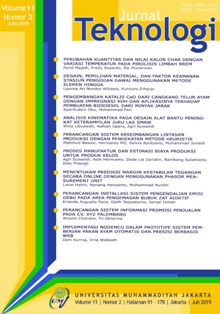ANALISIS KINEMATIKA PADA DESAIN ALAT BANTU PENINGKAT KETERAMPILAN JURU LAS SMAW
Main Article Content
Abstract
Downloads
Article Details
COPYRIGHT POLICY
The author(s) of an article published in the Jurnal Teknologi retains ownership of the intellectual property rights in work (s).
PUBLISHING RIGHTS
The author(s) of an article published in the Jurnal Teknologi have unrestricted publication rights. The authors give the Jurnal Teknologi the right to publish the article and designate the Faculty of Engineering Universitas Muhammadiyah Jakarta Publishing as the original publisher of the article.
LICENSING POLICY
Journal of Mechanical Engineering and Sciences is an open-access journal that follows the Creative Commons Non-Commercial 4.0 International License (CC BY-NC 4.0), which states that:

Under this license, the reusers must give appropriate credit, provide a link to the license, and indicate if changes were made. Users may do so in any reasonable manner, but not in any way that suggests the licensor endorses users or their use.
Please take the time to read the whole license agreement (https://creativecommons.org/licenses/by-nc/4.0/). As long as reusers follow the license conditions, the owner cannot withdraw these freedoms. The following components are included under this license:
 Attribution: Users must provide appropriate attribution, including a link to the license, and indicate whether or not they made any modifications. Users are free to do so reasonably, but not in a manner that indicates the licensee approves of their usage.
Attribution: Users must provide appropriate attribution, including a link to the license, and indicate whether or not they made any modifications. Users are free to do so reasonably, but not in a manner that indicates the licensee approves of their usage.
 NonCommercial: Users may not use the material for commercial purposes.
NonCommercial: Users may not use the material for commercial purposes.
References
AEC, A. (2015, November 22). ASEAN Economic Community: Blueprint 2025. Retrieved Mei 6, 2016, from ASEAN Economic Community: http://www.asean.org/asean-economic-community/
American Welding Society. (1976). AWS Welding Handbook Seventh Edition: Fundamentals of Welding (Vol. 1). Florida, America: American Welding Society. doi:10.1007/978-1-349-03073-6
Barrentine, L. B. (1999). An Introduction to design of experiments. Winsconsin: ASQ Quality Press.
Chambers, T., Aglawe, A., Reiners, D., White, S., Borst, C. W., Prachyabrued, M., & Bajpayee, A. (2012). Real Time Simulation for a virtual reality-based MIG welding training system. 16, 45-55. doi:10.1007/s10055-010-0170-x
Commission, I. (2014). IIW Commission XIV workshop success: showcasing latest international developments in welding training systems. Australian Welding Journal, 18-22.
Committee, A. I. (2011). ASM Handbook; Volumeo6A- Welding Fundamentals and Process. Ohio: ASM Interntional.
Liu, Y., & Zhang, Y. (2014). Control of Human Arm Movement in Machine-Human Cooperative Welding Process. Control Engineering Practice, 32, 161-171. doi:10.1016/j.conengprac.2014.08.003
Liu, Y., Zhang, W., & Zhang, Y. (2014). A tutorial on learning human welder's behavior: Sensing, modeling, and control. Journal of Manufacturing Processes, 16, 123-136. doi:10.1016/j.jmapro.20
Mendes, N., Neto, P., Loureiro, A., & Moreira, A. P. (2016). Machines and control systems for friction stir welding: A review. Materials and Design, 90, 256-265. doi:10.1016/j.matdes.2015.10.124
Okimoto, M. L., Okimoto, P. C., & Goldbach, C. E. (2015). User Experience in Augmented Reality Applied to the Welding Education. 6th International Conference on Applied Human Factors and Ergonomics(AHFE) and Affiliated Conference (pp. 6223-6227). Elcevier B.V. doi:10.1016/j.promfg.2015.07.739
Penrod, V. M., Reichert, C. T., Boulware, P. C., & Conrardy, C. C. (2011, January 13). Patent No. US 2011/0006047 A1. USA.
Teeravarunyou, S., & Poopat, B. (2009). Computer based Welding Training System. International Journal of Industrial Engineering, 16 (2), 116-125.
Ulrich, K. T., & Eppinger, S. D. (2012). Product Design and Development. Singapore: McGraw-Hill.
Vinogradov, O. (2000). Fundamentals of Kinematics and Dynamics of Machines and Mechanisms. Florida: CRC Press LLC.
W.J, Z., & Y.M, Z. (2012, November). Modeling of Human Welder Response to 3D Weld Pool Surface: Part I-Principles. Welding Journal, 91, 310-B-318B.
W.J, Z., & Y.M, Z. (2013, May). Dynamic Control of GTAW Process Using a Human Welder Response Model. Welding Journal, 92, 154-B-166-B.
Wu, L., Cheon, J., Kiran, D. V., & Na, S.-J. (2016). CFD simulations of GMA welding of horizontal fillet joints based on coordinate rotation of arc models. Journal of Materials Processing Tech., 231, 221-238. doi:10.1016/j.jmatprotec.2015.12.027
Yakub, A., Karmiadji, D. W., & Ramadhan, A. I., (2015). Optimasi Desain Rangka Sepeda Berbahan Baku Komposit Berbasis Metode Anova. Jurnal Teknologi., 8 (1), 17-22. doi: 10.24853/jurtek.8.1.17-22
Zboray, D. A., Bennett, M. A., Wallace, M. W., Jeremiah, H., Dudac, Y. C., Lenker, Z. S., . . . Preisz, E. A. (2014). Patent No. US8747116 B2. USA.

